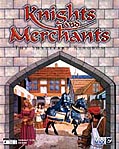What do you get when you mix one part Lords of the Realm II and about nine parts The Settlers II? You end up with Knights and Merchants. This real-time empire-building game offers a decent story and good graphics. After the first 15 to 20 minutes, however, Knights and Merchants fades fast due to some mind-boggling design flaws and tedious, uninteresting gameplay.
You begin the game as a captain of the guard in the service of a deposed king. Recently usurped, the king maintains control over a single province only. Your job is to win back control of the entire kingdom, one province at a time. There are 20 missions in all, with one province hanging in the balance on each. This is the first area in which the game stumbles: On most missions, it is entirely unclear what the specific goal is. You can stumble around the map for a while until you find it, but that wastes precious time - the game sucks up enough time as it is, with each mission lasting about an hour.
The game has two elements: town building and combat. The process of town building is virtually identical to town building in The Settlers II. You must build a variety of special-purpose buildings, then connect them with roads so that your peasants can transport goods and materials back and forth over your burgeoning kingdom. Stumbling block number two: Road building takes far too long, ties up too many of your people, and is simply too arduous a task for such a crucial element of gameplay. The real problem is that every piece of every road must be paved, so a peasant must carry rock from the storehouse to each road segment. The big question is: Why pave these roads? There are no wheeled units in the game, and I'm fairly certain that quite a few medieval towns were built around dirt thoroughfares.
Then there's the process of building the various structures for your town. This element of the game is pretty well implemented. You have a vast array of buildings to choose from, and they each rely on one or two others to be productive. For example, the armory workshop makes leather armor. In order to do so, it must receive leather rolls from the tannery, which in turn needs skins from the swine farm, which must get wheat from the farm. A fairly realistic dependency structure, though the game could do a better job of informing players about lapses in the production cycles. If one of the structures in the chain drops the ball (such as when your tanner leaves his shop to eat at the tavern), your armory comes to a grinding halt, and the game provides no audio or text messages to warn you. Instead, you simply have to see it for yourself by watching your subjects like a hawk. And if you do notice a problem, there's very little you can do as you have no direct control over any people other than the military units.
Which brings us to the combat segment of the game. Your primary goal, after all, is the military conquest of the lost provinces. In order to build up a powerful army, you need to assemble ax fighters, pikemen, archers, and a variety of other potent troops. These units can be trained in your castle, so long as you have the recruits, the weapons, and the armor necessary for the desired unit type. Once trained, you can group like units, move them about, and change their facing and formation.
Combat would be the game's best feature, if not for some annoying artificial intelligence problems, idiotic unit pathing, and anarchic formation behavior. Computer-controlled armies tend to sit back on the defensive at all times, unless you goad them into a fight. Even on missions where you are supposedly on the defensive, the computer was content to let me build up my town and my army before attacking. Pathing problems are plentiful both in combat and in deploying troops from the castle to the front lines. Units often mill about in front of the castle even after you order them elsewhere, presumably because they can't figure out the best path. In combat, units often stack two and three deep rather than encircling an enemy. The result is that you have a few soldiers fighting while the rest wait for someone to die so that they can take his place in line.
To make matters worse, your armies need frequent supply breaks, a process that brings forth peasants with sausages and wine - and results in utter mayhem for your once-neat formations. After being resupplied, your units are often scattered all over the place, facing several different directions. This leaves them extremely vulnerable to attack (and of course, this seems to be the only time the computer takes the initiative).
The game isn't entirely bad, however. The graphics are quite good, with excellent unit animations for everything from jabbing with a lance to crushing grapes for wine. Ambient life is evident on most missions, including crabs on the beach and foxes scampering through the forest. The landscapes are nicely rendered also. The game's musical score is suitably medieval, and the sound effects are very good. Knights and Merchants offers a decent complement of multiplayer options as well, including village-building and combat-only scenarios.
But overall, this game just doesn't impress. It's hard to recall another game in which you have so little direct control over events, and yet are called upon for so very much micromanagement. The good news for fans of this sort of game is that The Settlers III is right around the corner.
By Michael E. Ryan
Posted 10/21/98


